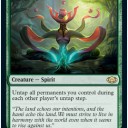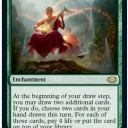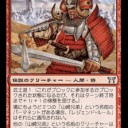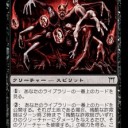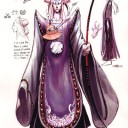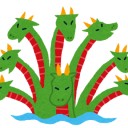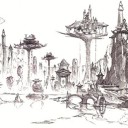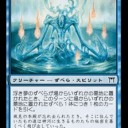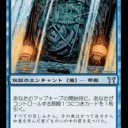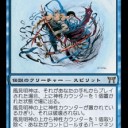Commander Collection: Green is a boxed set of eight reprinted cards themed to one color and what it does best—in this case green, the color of big mana and big creatures! These cards have been selected to showcase the things green mages love to do in Commander, and each one has been given brand-new art with loads of references to popular legendary characters. They’ll be right at home in your favorite green deck alongside their legendary counterparts!
There are two versions of Commander Collection: Green—a regular and a premium edition. All WPN will be able to order the regular version, which contains all eight cards in non-foil. The premium edition will be exclusive to WPN Premium stores and will contain all eight cards in gorgeous foil!
Commander Collection: Green will be available in English exclusively at your local store beginning December 4, 2020.
引用元
COMMANDER COLLECTION: GREEN PACKAGING AND CONTENTS Posted in News on August 22, 2020
https://magic.wizards.com/en/articles/archive/news/commander-collection-green-packaging-and-contents-2020-08-22
統率者戦向けセット『COMMANDER COLLECTION: GREEN』のカードリストが発表されました。
そこで、《種子生まれの詩神/Seedborn Muse》と《森の知恵/Sylvan Library》が新しく神河のものになって再録されました。
前者は、フレイバー・テキストが「梓日記/Diary of Azusa」、つまり《迷える探求者、梓/Azusa, Lost but Seeking》の書物であることから分かります。
"The land echoes our intentions, and the kami echo the land. We must strive to live in harmony with the world even when it seems to rise against us."
—Diary of Azusa
神河らしく古文風に訳すと、以下のようになるでしょうか。大地や神との調和を重んじるのは、緑のモンクたる梓らしいと言えます。
土地は我らの意思を響かせ、神は土地を響かせる。世界が我らに背くようにみえても、我らは世界と調和して生きるよう努めねばならぬ。
――― 梓日記.
また、能力的にも、梓で土地を並べて、相手のターンにアンタップするのは相性がいいでしょう。
後者は、フレイバー・テキストがありません。ただ、イラストで琵琶を弾いている僧侶が、《神河の歴史、暦記/Reki, the History of Kamigawa》に似ていることから、神河であると考えるのが自然です。どちらも手札を増やすことに関する能力であり、類似性があります。
このように、過去の「神河でないカード」が神河のカードとして再録されることは以前の告知(※1)にあった通りです。こうした形でも神河を目にする機会が今後増えてくると嬉しい限りです。
※1
神河資料 - 『COMMANDER COLLECTION: GREEN』の告知
https://researchofkamigawa.diarynote.jp/202001301708071026/
神河資料 - 梓と祭殿サイクルの評価
2020年8月23日 Magic: The Gathering『基本セット2021』
プレイヤーに再録が大好評だった
もう1つ好評の声が多かったものが、今回の心躍らせる再録カード(《不気味な教示者》《精霊龍、ウギン》《迷える探求者、梓》《真面目な身代わり》《漁る軟泥》《封じ込める僧侶》など)だった。多かった意見は「もっとやってください」というものだった。
祭殿は成功だった。
私のブログで最も多いコメントは、神河を再訪してほしいというものだ。それは難しい話だが、新しい祭殿のサイクルを作ることで神河ファンにその雰囲気だけでも届けることができたことには満足している。送り主が神河ファンか祭殿ファンか両方のファンかはわからないが、これについての好評はたくさん届いているのだ。
引用元
Making Magic -マジック開発秘話- 2020.8.18 デザイン演説2020
https://mtg-jp.com/reading/mm/0034274/
一年間を振り返って、良い点も悪い点も語る記事「デザイン演説」の最新版です。
神河には直接再訪こそしませんが、神河要素のある再録《迷える探求者、梓》と、新規カード祭殿サイクルがありました。
その評価は良かったようで、何よりです。わざわざ1つの項目を設けるほど、扱いの大きいものです。
再訪は依然として難しいことも書かれています。これは仕方ありません。
何度も公式記事で失敗セットの代表例のように扱われてきながらも、一方で新規カードも作られているというのは希少です。そういう独特なポジションを確立しているとも言えるでしょう。
神河当時 - プレイテストの影響
2020年8月22日 Magic: The Gathering
昨日の記事の続きです。
プレイテストによって、実際どれだけのカードが変更を受けたのか、という話です。
ここでは、《山崎兄弟/Brothers Yamazaki》《残酷な詐欺師/Cruel Deceiver》《明けの星、陽星/Yosei, the Morning Star》本殿サイクルなどの調整について言及されています。
ただ、それらは自分たちでなくても、開発は気づいたのではないか、とのことです。
率直とも謙虚とも言える姿勢です。
こう言っておいて、禁止カードをスルーしていた、というようなことがなくて良かったものです。
We had an impact. Or maybe not.
We cannot say for sure what direct effects we had on this set. Our egos would love to take some credit for alerting development to the potential problems with an earlier version of Brothers Yamazaki (a.k.a. "Stanggmaker"). We constructed one or two really stupid decks that may have had something to do with the disappearance of cards I can’t tell you about. We’d like to think Cruel Deceiver (a.k.a. "The Black Bluffer") has a better ability because we suggested the bluffers could have more punch; that Yosei, the Morning Star is fun now instead of ridiculously unfun because we pointed out an earlier version’s amazing power level in group; that the five Honden have staggered mana costs in allied colors because we found earlier versions difficult to work together; and that the set has a few more spirits and arcane spells because we enthused about the flavor there.
But in all scientific honesty, given the amount of testing development does on its own and the large number of other people they depend upon for opinions, I imagine development (and/or another playtest group) would have found and corrected these problems without our help. Magic isn’t a game made by a single guy pulling a lever in a back room. It takes a community of people, and a great deal of coordination, to get a set from "good idea" to "good execution". We’re just glad we carried our own weight.
引用元
DOWN TO EARTH Posted in Serious Fun on October 19, 2004
https://magic.wizards.com/en/articles/archive/serious-fun/down-earth-2004-10-19
プレイテストによって、実際どれだけのカードが変更を受けたのか、という話です。
ここでは、《山崎兄弟/Brothers Yamazaki》《残酷な詐欺師/Cruel Deceiver》《明けの星、陽星/Yosei, the Morning Star》本殿サイクルなどの調整について言及されています。
ただ、それらは自分たちでなくても、開発は気づいたのではないか、とのことです。
率直とも謙虚とも言える姿勢です。
こう言っておいて、禁止カードをスルーしていた、というようなことがなくて良かったものです。
神河当時 - プレイテストの時間と見落とし
2020年8月21日 Magic: The Gathering
昨日の記事の続きです。
テストプレイにどれだけの人数や時間がかかったのか?という話です。
あくまでもこの著者の試算・推測ですが、平均8人のプレイヤーが、10回のプレイテストを6時間ずつ行った、とのことです。
また、特定のカードの強さについて見落としについても触れています。《頭蓋骨絞め/Skullclamp》については明らかな見落としと認めた上で、それはミラディン・ブロックの600枚以上のカードのうち、1/600=0.17%に過ぎない、とも述べています。トレーニングカードゲームとしては、充分な精度であり、『神河物語』ブロックでもそれと同程度でも達成できれば功績として誇るそうです。
もっとも、この後もミラディン・ブロックからは禁止カードが出てしまうのは周知の通りです。さすがにそれを含めてしまうと、充分な精度とは言えないでしょう。
昨今のスタンダードで禁止カードが過去最大級に連発していることもあり、なんとも複雑な気分です。
What We Learned
Design & development works hard. We knew this already, of course. But it was helpful to be able to begin to quantify. By my estimate, our project took quite a bit of time: an average of eight players times ten playtest sessions at about six hours per session equals 480 man-hours of actual play with the cards. This doesn’t count unscheduled "jam" sessions between just two or three of us, or the phone and email conversations we’d have with each other in between, or the filling out of surveys and other analysis we did.
Of course, we’re just one playtest group. We can only speculate on how many other playtest groups, in however many other formats, development uses. And all of that farmed-out playtesting is just a fraction of what development does to analyze and refine the cards themselves. And all of that doesn’t count the work design had already done, before we even got the stickers in hand.
And all of that doesn’t count whatever work any or all of these people have now done on the next couple of sets, which need to fit thematically and structurally with Champions.
Occasionally on the message boards, I see folks who blame individual Wizards employees for "missing" how good a specific card is. While I respect customers’ rights to give feedback, such criticism looks a whole lot more useful to me when it comes from someone who seems to grasp what these people do. Mirrodin block went by with something over 600 cards printed. Skullclamp’s power was apparently an oversight. There are certainly industries where 99.83% accuracy is not good enough; but collectible card games probably isn’t one of them. I’ll happily take partial credit if Kamigawa achieves the same rate.
引用元
DOWN TO EARTH Posted in Serious Fun on October 19, 2004
https://magic.wizards.com/en/articles/archive/serious-fun/down-earth-2004-10-19
テストプレイにどれだけの人数や時間がかかったのか?という話です。
あくまでもこの著者の試算・推測ですが、平均8人のプレイヤーが、10回のプレイテストを6時間ずつ行った、とのことです。
また、特定のカードの強さについて見落としについても触れています。《頭蓋骨絞め/Skullclamp》については明らかな見落としと認めた上で、それはミラディン・ブロックの600枚以上のカードのうち、1/600=0.17%に過ぎない、とも述べています。トレーニングカードゲームとしては、充分な精度であり、『神河物語』ブロックでもそれと同程度でも達成できれば功績として誇るそうです。
もっとも、この後もミラディン・ブロックからは禁止カードが出てしまうのは周知の通りです。さすがにそれを含めてしまうと、充分な精度とは言えないでしょう。
昨今のスタンダードで禁止カードが過去最大級に連発していることもあり、なんとも複雑な気分です。
神河当時 - プレイテストのイラスト
2020年8月20日 Magic: The Gathering
昨日の記事の続きです。
テストプレイにおいて、神河はイマイチ魅力を感じにくかった、とのことです。
というのも、テスト段階では、イラストもフレイバーテキストもありません。これはどのセットのテストでも同じことですが、神河は初のトップダウンセットであり、フレイバー重視のセットです。イラストなどがなければ、肝心のフレイバーが半減するのは当然でしょう。
また、神河においては多人数戦もテストしています。人数が多ければ、カードが遠い場所に置かれることも珍しくありません。そうなると、文字だけでカードを把握するのは大変だったようです。
いずれも、神河ならではの状況と言えます。
なお、連繋を他のプレイヤーの呪文とも可能にするアイデアがあったようです。実際には没になりましたが。
So – Did We Like It? And Do We Now?
We did like the set okay back then, though we all agreed it appeared less eye-popping than Invasion or Mirrodin. We knew full well that not being able to see the artwork, flavor text, final card titles, and other aspects were keeping us from appreciating fully a set that was obviously based on flavor.
And I think (though I haven’t formally polled everyone in the group) that we like the set better now. The changes they made were definitely in the right direction. And they’ve set themselves up beautifully for the next two sets.
When it came time for the final survey, I was both enthusiastic and honest. Here are excerpts of my email to Elaine and the development team:[Flippers are] winners…[they] range from solid to excellent. Even if it sucks to figure out how to do this with artwork and such, please keep them in! (I assume that there will be an innovative card face involved, e.g.card split into thirds. If that’s not the case, this may not be as cool as I think it is...but I’m optimistic!)…
[Legends are] the right note to hit for this set. You need to hit it MUCH harder…
[The dragons are] perhaps too good. Big effects when you "play from your hand" are easy to regulate – but graveyard-impact effects can happen in all sorts of cheap and easy ways. (Your new legend rule is one of them - two black dragons coming out at the same time from Patriarch’s Bidding is bad, bad news!) And Sneak Attack can put all five in, which may or may not be a problem for you - but I can guarantee it will rocket to the head of most multiplayer groups…
Flavor is incredibly important to multiplayer. We all knew that already; but our group learned that in spades with this experience…. It’s amazing how hard it is to follow the game when you can’t reference artwork…
I also gave Development four fairly aggressive recommendations involving legends. Bottom line, I felt Wizards had already done a great deal of cool stuff – and could do even more. (I still do.) I don’t know if they will adopt those recommendations or not before the block is done; so I won’t go into any further detail. But it was so cool having their ear on this!
As for the group as a whole, we had a fine idea to allow "splicing" to happen on any player’s arcane spells – what fun that would have been in multiplayer! – but of course, because splicing happens as you pay the cost of a spell, there’s no way for this practically to work. So they scrapped it, and rightly so. I continue to hold out hope that there’s a major mechanic or two out there that work fine in duels, but are even "more special" in multiplayer environments. And I have faith that as design and development find such mechanics, they’ll use them.
引用元
DOWN TO EARTH Posted in Serious Fun on October 19, 2004
https://magic.wizards.com/en/articles/archive/serious-fun/down-earth-2004-10-19
テストプレイにおいて、神河はイマイチ魅力を感じにくかった、とのことです。
というのも、テスト段階では、イラストもフレイバーテキストもありません。これはどのセットのテストでも同じことですが、神河は初のトップダウンセットであり、フレイバー重視のセットです。イラストなどがなければ、肝心のフレイバーが半減するのは当然でしょう。
また、神河においては多人数戦もテストしています。人数が多ければ、カードが遠い場所に置かれることも珍しくありません。そうなると、文字だけでカードを把握するのは大変だったようです。
いずれも、神河ならではの状況と言えます。
なお、連繋を他のプレイヤーの呪文とも可能にするアイデアがあったようです。実際には没になりましたが。
神河当時 - プレイテストのハイライト
2020年8月19日 Magic: The Gathering
昨日の記事の続きです。
プレイテストのハイライトとして、各メンバーの動向が書かれています。
新しいレジェンドルールを悪用して伝説ドラゴンサイクルのPIG能力を誘発させたり、ずべらと本殿の有用性を見出したり、と言った具合です。
後、多人数戦用に作られた《砂の逆流/Reverse the Sands》は大好きな人と大嫌いなプレイヤーとがいたようです。誰かに嫌われようと、別の誰かに愛されるようなカードであればいい、という話もありますし、これはこれで成功なのでしょう。
Dave Hanson becomes the first Magic player to abuse the "crash-dragons" and the new legendary rule. Within 24 hours of getting these "new cards" (they showed up in an email about halfway through our testing), Dave had the white, blue, and black versions in a deck with four copies of Buried Alive, Patriarch’s Bidding and…well, who cares what else. (Yes, we were also aware of Sneak Attack.) He could store and bring out either one each of blue, black, and white – or double them up and let the "legend rule" do the rest. It was devastating – not least because Yosei used to have an even more powerful tap-down effect than it has now. Changes: Yosei’s ability is a bit more reasonable now.
Todd Petit and Bob Drosky become the first two fearless explorers to break the effigies and shrines. Like Lewis and Clark braving the Rocky Mountains, Drosky and Petit demonstrated in both limited and constructed multiplayer formats that these unassuming 1/2 zubera and matching legendary honden do have their uses. Sort of. Occasionally. When the light is right. Changes: the zubera are pretty much identical to when we last saw them. The honden have different (staggered) casting costs.
Paul Hemze borrows a buddy. "Borrow Buddy" was the playtest name for Blind with Anger. Every other game, Paul would look at an attacking creature, cry out "borrow buddy!" in his silliest voice, and then wreck some other poor guy who happened to have a decent non-legendary blocker available. Of course we knew this was good – it’s the latest variant of Ray of Command – but the amazing frequency with which Paul pulled this off is still noteworthy. Changes: No change to this card from when we last saw it.
Joe Santos reverses some sands. During my preview of Reverse the Sands, I was unable to reveal that our group already had fairly intimate knowledge of this card. Joe loved it (then called "Vice Versa") and played it constantly. I hated it, and still hate it even though I’ll probably use it myself. It’s that kind of card. Changes: They bumped up the cost by 1. We didn’t tell them to do this; but we’re glad they did.
Todd Petit makes a three-fer deck. There was a potion involved, and a lot of stupid brokenness. I forget the rest and I’m glad; decks like Todd’s really don’t deserve even this much press. Changes: The card isn’t in the set anymore. Let’s all just hope they don’t try this one again.
引用元
DOWN TO EARTH Posted in Serious Fun on October 19, 2004
https://magic.wizards.com/en/articles/archive/serious-fun/down-earth-2004-10-19
プレイテストのハイライトとして、各メンバーの動向が書かれています。
新しいレジェンドルールを悪用して伝説ドラゴンサイクルのPIG能力を誘発させたり、ずべらと本殿の有用性を見出したり、と言った具合です。
後、多人数戦用に作られた《砂の逆流/Reverse the Sands》は大好きな人と大嫌いなプレイヤーとがいたようです。誰かに嫌われようと、別の誰かに愛されるようなカードであればいい、という話もありますし、これはこれで成功なのでしょう。
神河当時 - 多人数戦のプレイテスト
2020年8月18日 Magic: The GatheringMagic: The Playtesting
The disclaimer: Even in this column, on this site, and after the fact, I’m limited in what I can reveal to readers. Neither my friends nor I can answer any speculation on what happened during playtesting. But Randy and the good folks at Wizards will let me speak to a couple of cards and experiences we had.
The team: The ten who tested regularly were Bob Drosky, David Hanson, Paul Hemze, Curt Jorenby, George Maverick, Don Musch, Todd Petit, Joe Santos, Paul Shriver, and myself. None of us are anyone of particular import in the Magic world, though you might occasionally catch one or two of us at Magic Online.
The mission: Our job was to focus on the card(s) in non-sanctioned formats, with an emphasis on multiplayer. We were given specific instruction not to care about whether a card was a bomb or not for limited/constructed tournaments. So if you have a problem with a card that’s "not costed right for Standard"…well, you’re looking at the wrong playtesters.
We tested virtually every card they gave us (setting aside repeats like Stone Rain) at least once in real-multiplayer-game conditions. The formats ranged from simple chaos to "hunt" (restricted target) to Two-Headed Giant to constructed Emperor to draft emperor.
引用元
DOWN TO EARTH Posted in Serious Fun on October 19, 2004
https://magic.wizards.com/en/articles/archive/serious-fun/down-earth-2004-10-19
プレイテストに関する記事です。
『神河物語』のテストプレイ時には、多人数戦に焦点を当てることが仕事でした。そのため、構築に適したコストか、リミテッドにおいてボムか、といったことは気にしないように指示されていました。
そして、多人数戦フォーマットとして、皇帝戦や双頭巨人戦などを一通り試しました。
今にして思えば、プレビューやその後の記事において、多人数戦を意識した話が多かったのはそういうことだったのかと、納得できます。
神河当時 - 開発メンバーの動向
2020年8月17日 Magic: The Gathering
昨日の記事の続きです。
筆者も含めたデザインチームのメンバーの動向について語られています。特に、興味・関心が多様であったことが分かります。
Brian Tinsman … 呪文を超自然的な武術として考える。コモンカードのデザインに注力。
Brady Dommermuth … 戦闘用のキーワードメカニズムを思案。ただし、武士道の発案者ではない。
Mike Elliott … フレイバー的意味の薄い抽象的なメカニズムと、戦闘用メカニズムの思案。「転生/Soulshift」の発案者らしい。
Bill Rose … コモンカードのデザイン調整。デザインのゲーム性への影響について担当。
意外にも、伝説はデザイン後期のことだったようです。神河にとって重要なテーマであるようですが、最初から掲げていたというよりは、最後の段階でカードにテーマ性・一貫性を持たせるために使われた、ように見えます。
2021/03/09 追記
日本語訳を見つけました。
一連の幸運:神河世界のデザイン――神河の巨大な世界の創造
https://web.archive.org/web/20041113050558/http://www.hobbyjapan.co.jp/magic/articles/files/20041025_01.html
But What About the Cards?
As you can see, Kamigawa’s creative infrastructure was part research and part accident. And because it developed over the course of months—months during which card design was supposed to be ongoing—the process of coming up with cards and mechanics was even more chaotic than usual. Each design-team member had a different interest and focus.
Brian Tinsman, the team lead, was interested in thinking about spells as supernatural martial arts moves. He was also focused on designing common cards. As I would later learn, designing good common cards is much harder and less fun than designing uncommon and rare cards, because commons have to be simpler, more nuts-and-bolts, more elegant. If it’s wacky (and I prefer wacky cards), chances are very good it’s not common.
I was busy trying to design a keyword mechanic for combat. I can’t be too specific in case we use any of my ideas in future sets, but some of the mechanics I designed were “overawe,” “bladework,” “finesse,” “fealty,” “taunt,” “fury,” . . . there were about 20 in all. (Sadly, the bushido ability we chose in the end wasn’t one of my designs.) I was also slaving away on commons.
Mike Elliott was working on what he does best: abstract mechanics (the ones without super-definable flavor such as echo and cycling). His work would eventually yield soulshift. Mike was also doing some combat-keyword design.
In the meantime, Bill (a busy guy by any measure) was overseeing our efforts, shaping the common-card designs and weighing in on the ideas we produced and whether they would yield good cards and good gameplay or not. He contributed material of his own, as well.
The last piece of the Kamigawa puzzle wouldn’t come until months later, and it became a real lynchpin of the design: legendary creatures. But that story is worth an article in and of itself.
引用元
A SERIES OF FORTUNATE EVENTS: KAMIGAWA WORLD DESIGN Posted in Feature on October 18, 2004
https://magic.wizards.com/en/articles/archive/feature/series-fortunate-events-kamigawa-world-design-2004-10-18
筆者も含めたデザインチームのメンバーの動向について語られています。特に、興味・関心が多様であったことが分かります。
Brian Tinsman … 呪文を超自然的な武術として考える。コモンカードのデザインに注力。
Brady Dommermuth … 戦闘用のキーワードメカニズムを思案。ただし、武士道の発案者ではない。
Mike Elliott … フレイバー的意味の薄い抽象的なメカニズムと、戦闘用メカニズムの思案。「転生/Soulshift」の発案者らしい。
Bill Rose … コモンカードのデザイン調整。デザインのゲーム性への影響について担当。
意外にも、伝説はデザイン後期のことだったようです。神河にとって重要なテーマであるようですが、最初から掲げていたというよりは、最後の段階でカードにテーマ性・一貫性を持たせるために使われた、ように見えます。
2021/03/09 追記
日本語訳を見つけました。
一連の幸運:神河世界のデザイン――神河の巨大な世界の創造
https://web.archive.org/web/20041113050558/http://www.hobbyjapan.co.jp/magic/articles/files/20041025_01.html
昨日の記事の続きです。
緑が一番難航した様です。伝統的クリーチャーのエルフは日本の伝承には登場しません。伝承によく出てくるのは狸ですが、下品だったり酔っぱらってやらかしたりという、イメージがついていることから不適切とされてしまいました。
そんな中、一徳氏が見せたスケッチ、四つ腕の蛇の忍びによって、即決定となった、とのことです。
イラストの段階で、蛇の忍者がいたことは興味深いです。私のオリジナルエキスパンションでは緑にも忍者がいましたが、公式でも緑の忍者が作られる可能性はあったと言えます。
2021/03/09 追記
日本語訳を見つけました。
一連の幸運:神河世界のデザイン――神河の巨大な世界の創造
https://web.archive.org/web/20041113050558/http://www.hobbyjapan.co.jp/magic/articles/files/20041025_01.html
Of all the humanoid races, we were most stumped in green. I had asked early on that elves be left out of the setting entirely, because they have no equivalent in Japanese lore. I thought another creature from the folklore might serve as a basis—the tanuki, or raccoon-dog—but the tanuki stories are all bawdy and comical. Tanuki are often represented as drunk and lusty, with oversized private parts and whatnot. Not appropriate for Magic. Then, during the very first day our concept-illustration team met as a group, Ittoku showed a sketch of a four-armed snake shinobi he had been working on. I immediately asked if we could use it, and work started on developing the orochi.
引用元
A SERIES OF FORTUNATE EVENTS: KAMIGAWA WORLD DESIGN Posted in Feature on October 18, 2004
https://magic.wizards.com/en/articles/archive/feature/series-fortunate-events-kamigawa-world-design-2004-10-18
緑が一番難航した様です。伝統的クリーチャーのエルフは日本の伝承には登場しません。伝承によく出てくるのは狸ですが、下品だったり酔っぱらってやらかしたりという、イメージがついていることから不適切とされてしまいました。
そんな中、一徳氏が見せたスケッチ、四つ腕の蛇の忍びによって、即決定となった、とのことです。
イラストの段階で、蛇の忍者がいたことは興味深いです。私のオリジナルエキスパンションでは緑にも忍者がいましたが、公式でも緑の忍者が作られる可能性はあったと言えます。
2021/03/09 追記
日本語訳を見つけました。
一連の幸運:神河世界のデザイン――神河の巨大な世界の創造
https://web.archive.org/web/20041113050558/http://www.hobbyjapan.co.jp/magic/articles/files/20041025_01.html
神河当時 - 神河次元のヒューマノイド 黒と赤
2020年8月15日 Magic: The Gathering
昨日の記事の続きです。
黒の種族は、すでにMTGに一定数存在し、日本の伝承にも登場することから、ネズミがすんなりと決まりました。
赤の種族は、ゴブリンであることはすぐに決まりました。日本の伝承にも、顔が赤くて鼻が長い天狗=ゴブリンが登場するから、とのことです。ただ、実際の天狗とは違ったものにしたい、ということから、河童のような甲羅が付け足されました。これは、コンセプトイラストレーターである一徳氏のデザインです。
神河におけるゴブリンは、天狗(採用理由)と河童(甲羅)と鬼(役割)とを混ぜ合わせた、かなり特殊なスタンスだと言えます。
2021/03/09 追記
日本語訳を見つけました。
一連の幸運:神河世界のデザイン――神河の巨大な世界の創造
https://web.archive.org/web/20041113050558/http://www.hobbyjapan.co.jp/magic/articles/files/20041025_01.html
Black was easy, because rats are both a Magic staple and a fixture of Japanese lore. Also, we wanted to avoid undead, since they blur the line of division between kami and living creatures.
Red was harder. As I mentioned above, Japanese folklore has goblins, but we wanted Kamigawa’s goblins to look different from the silly, long-nosed tengu in the real-world lore. We got our answer when one of our concept illustrators, Ittoku, drew his version of a goblin. He had taken a kappa, a turtle-like river spirit, and envisioned the goblins as “fire kappa.”
引用元
A SERIES OF FORTUNATE EVENTS: KAMIGAWA WORLD DESIGN Posted in Feature on October 18, 2004
https://magic.wizards.com/en/articles/archive/feature/series-fortunate-events-kamigawa-world-design-2004-10-18
黒の種族は、すでにMTGに一定数存在し、日本の伝承にも登場することから、ネズミがすんなりと決まりました。
赤の種族は、ゴブリンであることはすぐに決まりました。日本の伝承にも、顔が赤くて鼻が長い天狗=ゴブリンが登場するから、とのことです。ただ、実際の天狗とは違ったものにしたい、ということから、河童のような甲羅が付け足されました。これは、コンセプトイラストレーターである一徳氏のデザインです。
神河におけるゴブリンは、天狗(採用理由)と河童(甲羅)と鬼(役割)とを混ぜ合わせた、かなり特殊なスタンスだと言えます。
2021/03/09 追記
日本語訳を見つけました。
一連の幸運:神河世界のデザイン――神河の巨大な世界の創造
https://web.archive.org/web/20041113050558/http://www.hobbyjapan.co.jp/magic/articles/files/20041025_01.html
神河当時 - 神河次元のヒューマノイド 白と青
2020年8月14日 Magic: The Gathering
昨日の記事の続きです。
神以外の住民に関する話です。
神河には人間が5色すべてにいますが、各色において少数派とされています。つまり、人間に似た生物、ヒューマノイドを創る必要がありました。
白は狐です。ただし、白にふさわしい種族として狐を選んだのではなく、先に狐を使うことが決まり、ふさわしい色として白が選ばれました。狐が選ばれたのは日本の民間伝承の中でもよく登場することからです。そして、人間をピンチから助ける物語に惹きつけられたことから、白になりました。
青はムーンフォークという神河次元固有の種族です。これは著者の好きな物語である「かぐや姫」に出てくる、月に住む人々が由来とされています。
2021/03/09 追記
日本語訳を見つけました。
一連の幸運:神河世界のデザイン――神河の巨大な世界の創造
https://web.archive.org/web/20041113050558/http://www.hobbyjapan.co.jp/magic/articles/files/20041025_01.html
Beyond Humanity
The final piece came from another one of my self-imposed restrictions. I think Magic should be about cool creatures, not just humans. That’s why although humans appear in all five colors, they’re outnumbered by other kinds of creatures in each color. So we needed other humanoids to round out the material world. And we wanted these humanoids to represent both Japanese myths and Magic.
Foxes, kitsune, were an easy choice, because they’re such a tremendously important feature of Japanese folklore. The real question was, given the richness and variety of fox stories, what color should they be? That question was answered by Alexander O. Smith, a freelance writer who has done a lot of research on fox stories. He was fascinated by the stories in which foxes were mysteriously benevolent, aiding humans in need or in peril. This image, like the four below it, is one of the concept sketches done for us by Ittoku.
The blue humanoid choice came from one of my favorite Japanese tales, the story of Lady Kaguya (sometimes called “The Bamboo Cutter and the Moon Maiden”). In this story, a simple peasant finds a tiny woman inside a bamboo stalk, and she grows to become the most beautiful woman in Japan. But the night before she is to be courted by the mikado himself, strange celestial beings descend in chariots from the moon and take her “home.” Thus the moonfolk were created.
引用元
A SERIES OF FORTUNATE EVENTS: KAMIGAWA WORLD DESIGN Posted in Feature on October 18, 2004
https://magic.wizards.com/en/articles/archive/feature/series-fortunate-events-kamigawa-world-design-2004-10-18
神以外の住民に関する話です。
神河には人間が5色すべてにいますが、各色において少数派とされています。つまり、人間に似た生物、ヒューマノイドを創る必要がありました。
白は狐です。ただし、白にふさわしい種族として狐を選んだのではなく、先に狐を使うことが決まり、ふさわしい色として白が選ばれました。狐が選ばれたのは日本の民間伝承の中でもよく登場することからです。そして、人間をピンチから助ける物語に惹きつけられたことから、白になりました。
青はムーンフォークという神河次元固有の種族です。これは著者の好きな物語である「かぐや姫」に出てくる、月に住む人々が由来とされています。
2021/03/09 追記
日本語訳を見つけました。
一連の幸運:神河世界のデザイン――神河の巨大な世界の創造
https://web.archive.org/web/20041113050558/http://www.hobbyjapan.co.jp/magic/articles/files/20041025_01.html
神河当時 - 「神の乱/Kami War」の経緯
2020年8月13日 Magic: The Gathering
昨日の記事の続きです。
マローが言う「制限は創造の母」の通り、神河において、著者はいくつかの制限を考えました。
1 他に類を見ない、日本的な設定
2 日本の文化を尊重し、固定観念に囚われない
3 常に5色と悪役クリーチャーの必要性を念頭に置いて、マジックに忠実であること
また、Bill Roseは「日本にインスパイアされたものである」という制限も設けたそうです。
日本の土着の宗教・神道においては、あらゆるものには神が宿ります。民話に百足や竜のような怪物が出たときも、それらは神とも呼ばれます。そうしたことから、神河における悪役が神に決まりました。
神を悪役として戦う、ということから、「間違った神道」というコンセプトが誕生しました。これが1や2の制限を満たします。
また、欧米人への親しみやすさから、神と戦う人々としてサムライなどが登場することになりました。
これが、「神の乱/Kami War」という『神河物語』ブロックの根本設定が生れたいきさつです。
「神の乱」は、上記の制約から生まれたものです。ということは、神河に再訪する際、同様に制約を設ければ、同様のストーリーになるのでしょうか。
しかし、神河は神と住民が戦うのが当たり前の次元ではありません。「神の乱」はあくまでもイレギュラーな事態です。とは言っても、登場するたびに神と戦っていては、そういう次元という印象になるでしょう。
上記のような制約を満たしつつも、従来とは違ったストーリーとはどのようなものか、色々想像してみています。
2021/03/09 追記
日本語訳を見つけました。
一連の幸運:神河世界のデザイン――神河の巨大な世界の創造
https://web.archive.org/web/20041113050558/http://www.hobbyjapan.co.jp/magic/articles/files/20041025_01.html
Rosewater’s Mantra
If you’ve read, say, two of Mark’s columns, you know that he believes that restrictions aid creativity. I think this is correct (most of the time), and it was definitely true with Kamigawa design. The first restriction came from Bill: This setting had to be Japan-inspired. The next batch of restrictions came from me: (1) Do a Japanese setting unlike any other. (2) Be respectful of Japanese culture by doing your homework and avoiding stereotypes. (3) Stay true to Magic by always keeping the five colors and the need for badass creatures in sight.
As I read more and more Japanese folklore, some patterns began to emerge. The first was transformation—things that seemed like one thing but were actually another, or things that actually became other things. As Mark wrote in “Flipping Out,” this theme would become the basis for the “night/day” mechanic, and would eventually end up on the “hero” cards.
This pattern dovetailed nicely with another one: In Shinto, the indigenous religion of Japan, everything has a divine essence, a kami. And often, when a monster such as a giant centipede or a humungous underground catfish (yes, really) or a dragon appeared in folk tales, it was referred to as a divinity, a kami. This would become the answer to our creature problem. The bizarre, badass creatures of Kamigawa wouldn’t just be monsters. They would be divinities of all shapes, sizes, and colors. They would be gods.
So a kind of accident led to the solution of multiple problems. If kami are the creatures of this world, why are they fighting? This question led to the “Shinto gone wrong” concept, which is the feature of Kamigawa that separates us from all other Japan-inspired settings. But what about the familiarity goal that started us on this path in the first place? That’s why we would also include all the elements of medieval Japan with which Western players are familiar: samurai, katana, ryuu/tatsu (dragons), and so on. And with bizarre kami on one hand and feudal Japanese social roles on the other, the Kami War was born.
引用元
A SERIES OF FORTUNATE EVENTS: KAMIGAWA WORLD DESIGN Posted in Feature on October 18, 2004
https://magic.wizards.com/en/articles/archive/feature/series-fortunate-events-kamigawa-world-design-2004-10-18
マローが言う「制限は創造の母」の通り、神河において、著者はいくつかの制限を考えました。
1 他に類を見ない、日本的な設定
2 日本の文化を尊重し、固定観念に囚われない
3 常に5色と悪役クリーチャーの必要性を念頭に置いて、マジックに忠実であること
また、Bill Roseは「日本にインスパイアされたものである」という制限も設けたそうです。
日本の土着の宗教・神道においては、あらゆるものには神が宿ります。民話に百足や竜のような怪物が出たときも、それらは神とも呼ばれます。そうしたことから、神河における悪役が神に決まりました。
神を悪役として戦う、ということから、「間違った神道」というコンセプトが誕生しました。これが1や2の制限を満たします。
また、欧米人への親しみやすさから、神と戦う人々としてサムライなどが登場することになりました。
これが、「神の乱/Kami War」という『神河物語』ブロックの根本設定が生れたいきさつです。
「神の乱」は、上記の制約から生まれたものです。ということは、神河に再訪する際、同様に制約を設ければ、同様のストーリーになるのでしょうか。
しかし、神河は神と住民が戦うのが当たり前の次元ではありません。「神の乱」はあくまでもイレギュラーな事態です。とは言っても、登場するたびに神と戦っていては、そういう次元という印象になるでしょう。
上記のような制約を満たしつつも、従来とは違ったストーリーとはどのようなものか、色々想像してみています。
2021/03/09 追記
日本語訳を見つけました。
一連の幸運:神河世界のデザイン――神河の巨大な世界の創造
https://web.archive.org/web/20041113050558/http://www.hobbyjapan.co.jp/magic/articles/files/20041025_01.html
神河当時 - 日本神話モチーフの課題
2020年8月12日 Magic: The Gathering
昨日の記事の続きです。
日本神話を選んだ後、様々な課題が見つかりました。
1 「神話」の意味合いが他国と異なる。ギリシャ神話や北欧神話の神々は現在ではだれも信じていないが、日本の神々は今も信仰されている。
2 多くの欧米人は、日本と言えば侍や忍者である。
3 多くの欧米人は、日本とその他アジアの文化を混同しがちである。
4 天狗、鬼、河童など、通常のマジックの色と役割に合わない。欧米人にとってなじみがない。
特に4については、天狗を例にしています。
外見は、長鼻の妖怪(赤のゴブリン)か鳥人(青白のエイヴン)
生息地は、森(緑)か山(赤)
こうした点をどのように工夫したのかは、この先でも触れられます。
仮に神河に再訪することがあったとしても、これらの課題は特に変わらないままです。別のアプローチでの解決を試みることがあるのでしょうか。
2021/03/09 追記
日本語訳を見つけました。
一連の幸運:神河世界のデザイン――神河の巨大な世界の創造
https://web.archive.org/web/20041113050558/http://www.hobbyjapan.co.jp/magic/articles/files/20041025_01.html
Respecting Japan
Over the next several days, I identified some challenges and problems with a Japanese-inspired setting. First and foremost, Japan doesn’t have a mythology per se, if by “mythology” you mean a pantheon of no-longer-worshipped gods. There’s folklore, of course, but all the “old gods” of Japan are still very much alive in Shinto and Buddhism. In other words, what would be considered mythology in the ancient Greek or Norse culture is current religious practice in Japanese culture.
Second, many Westerners just don’t know much about ancient and/or feudal Japan beyond samurai and ninja. Ask a typical American to name some elements of a Japanese-inspired fantasy setting, and they’ll name samurai, ninja, Eastern dragons, “honor,” maybe some medieval Japanese weapons . . . and that’s about it. And maybe they’ll throw in some random Chinese stuff, too.
Which brings me to the third problem: Many Westerners confuse Chinese or Korean cultural elements with Japanese, or worse, they don’t think the differences are significant. I felt very strongly that we shouldn’t do an Asian mishmash setting. To me, putting kung fu or Sun Tzu into a Japan-inspired setting is no different from creating a Babylonian-flavored setting and then populating it with Vikings.
The last major problem also derives from the second one: Magic is a game about creatures and spells, and yet most Westerners simply aren’t familiar with the creatures and magic of Japanese lore. Using words like “tengu,” “kappa,” “oni,” “shugendo,” and “onmyodo” will usually get you blank stares. And to make matters worse, the creatures of Japanese folklore are bizarre and complex, and many just won’t fit neatly into Magic’s five colors or its values.
Take tengu, for example, which are a major feature of Japanese folklore. Depending on what you read, they’re either long-nosed goblins or bird-men. They’re either honorable duelists or perverted tricksters. They’re forest dwellers, or maybe mountain dwellers. Now pick a color for these creatures. They’re sort of goblins, so they’re red. They’re bird-men, so they’re white or blue (like Aven). They’re forest dwellers, so they’re green. And in addition to all these complications, Westerners aren’t familiar with them anyway.
引用元
A SERIES OF FORTUNATE EVENTS: KAMIGAWA WORLD DESIGN Posted in Feature on October 18, 2004
https://magic.wizards.com/en/articles/archive/feature/series-fortunate-events-kamigawa-world-design-2004-10-18
日本神話を選んだ後、様々な課題が見つかりました。
1 「神話」の意味合いが他国と異なる。ギリシャ神話や北欧神話の神々は現在ではだれも信じていないが、日本の神々は今も信仰されている。
2 多くの欧米人は、日本と言えば侍や忍者である。
3 多くの欧米人は、日本とその他アジアの文化を混同しがちである。
4 天狗、鬼、河童など、通常のマジックの色と役割に合わない。欧米人にとってなじみがない。
特に4については、天狗を例にしています。
外見は、長鼻の妖怪(赤のゴブリン)か鳥人(青白のエイヴン)
生息地は、森(緑)か山(赤)
こうした点をどのように工夫したのかは、この先でも触れられます。
仮に神河に再訪することがあったとしても、これらの課題は特に変わらないままです。別のアプローチでの解決を試みることがあるのでしょうか。
2021/03/09 追記
日本語訳を見つけました。
一連の幸運:神河世界のデザイン――神河の巨大な世界の創造
https://web.archive.org/web/20041113050558/http://www.hobbyjapan.co.jp/magic/articles/files/20041025_01.html
神河当時 - 神話の世界
2020年8月11日 Magic: The GatheringIn mid-2002, around the time that development of the Mirrodin set was in full swing, folks in R&D started talking in earnest about Earth (regular readers will remember that the codenames for the Kamigawa block were Earth, Wind, and Fire). Bill Rose had a big idea: he wanted to do a set in which flavor was at least as important as mechanics, maybe more so. I was instructed to think about whether a particular kind of world or flavor would really knock players’ socks off, would excite them as much as some new mechanics.
Back to Reality
At the same time, Bill started getting fond of a particular idea: He wanted to try doing a Magic block that would take place in a world with which players were already familiar. Mirrodin was cool, but it was very “high concept,” and it really pushed the limits of what “fantasy” means. The only constant in Magic is change, so Bill thought maybe we should follow up a strange world with a familiar one. He also thought that doing a setting based on an Earth mythology would inspire card designers because they’d have a flavor basis from which to work.
I won’t lie to you — I disliked the whole idea. I didn’t want to go where other games had already been, and neither did art director Jeremy Cranford. We were proud of Mirrodin, and we knew our illustrators were excited to illustrate our metal world. We wanted to keep going in new directions, and a real-world-inspired setting felt like a step backward. But, see, there’s this thing: Bill Rose is the vice president of R&D. He tends to get his way.
As Mark Rosewater alluded to in his article “Now With Added Flavor,” I evaluated lots of Earth mythologies in an attempt to construct a short list of promising candidates for Bill. Greek? Too mundane, and we have already incorporated a lot of mythical Greek monsters into Magic. Celtic? Aztec? Sumerian? Too obscure. They could be cool, but the vast majority of players wouldn’t be familiar with them, thereby defeating the purpose of doing a real-world-based setting in the first place. Suffice it to say that the eventual list was short, alright. Like four items short.
Bill had found one real-world mythology particularly appealing, but there were some complications. (No, I won’t tell you which, because we’ll likely revisit the idea in the future.) Then something formative occurred. He attended a distributors’ meeting in Tokyo, Japan. When he came back, he had all but made up his mind that we would create a setting based on Japanese mythology.
引用元
A SERIES OF FORTUNATE EVENTS: KAMIGAWA WORLD DESIGN Posted in Feature on October 18, 2004
https://magic.wizards.com/en/articles/archive/feature/series-fortunate-events-kamigawa-world-design-2004-10-18
神河のコンセプトに関する記事です。
まず、Bill Rose副社長の「フレイバー重視でセットを作ろう」というアイデアが発端でした。そこから、地上の神話をベースにする、という方針になります。
ギリシャ神話については、関連したカードがすでに登場していたため没になりました。アステカ神話ではなじみがありません。そこで、ちょうどよい距離感だった日本神話が選ばれたということです。
もっとも、ギリシャ神話も、(神話というより文明ですが)アステカも、モチーフとした世界が後に作られるわけですが。最初からそれらを選んでいた場合、どうなっていたのかは気になります。少なくともギリシャ神話であれば、大外れになることは考えにくいでしょう。
2021/03/09 追記
日本語訳を見つけました。
一連の幸運:神河世界のデザイン――神河の巨大な世界の創造
https://web.archive.org/web/20041113050558/http://www.hobbyjapan.co.jp/magic/articles/files/20041025_01.html
神河当時 - 『神河物語』ドラフトの青白
2020年8月10日 Magic: The GatheringDrafting blue-white
You might well ask why I’m giving this short history lesson. It’s because, in part at least, it demonstrates some of the reasons why blue-white is looking particularly strong in this block.
First, there are no commons that just wreck you in this block. There’s no Sparksmith, no Timberwatch Elf and no Spikeshot Goblin that will single-handedly ruin your otherwise pleasant day. Frostwielder exists but it is slow and often doesn’t do too much damage by itself. On top of that you do have a permanent common solution to it in Mystic Restraints, which is a much better removal spell than it looks on the surface.
The second thing to note is that we have one of the best ’Pacifisms’ printed in a while in Cage of Hands. You can just throw this out there whenever you have a minute and if something scary turns up the majority of the time you’ll be in a position to return the Cage and drop it down on whatever nasty critter shows up. Having both Cage and Restraint in the common slots gives blue-white two very good ’removal’ spells, which it doesn’t normally get. Combine this with the fact that they both get around the Soulshift ability and can target both Spirit and non-Spirit creatures alike and you’ve obviously got a couple of winners. Blessed Breath and Consuming Vortex are respectable tricks too and can provide card advantage due to the Splice mechanic. Similarly Indomitable Will can generate a significant advantage as it often leaves behind a creature that’s a lot tougher for your opponent to deal with than the original problem they were trying to solve.
引用元
SORATAMI AND SAMURAI Posted in Limited Information on October 18, 2004
https://magic.wizards.com/en/articles/archive/limited-information/soratami-and-samurai-2004-10-18
『神河物語』のドラフトにおける、青白デッキについて、それ以前の環境とも比較しつつ語っている記事です。
優秀なフライヤー・妨害オーラ・強化オーラの存在から、特にアグロ系の評価が高いようです。
2021/03/09 追記
日本語訳を見つけました。
空民と侍――神河物語での青白のドラフト
https://web.archive.org/web/20041210092355/http://www.hobbyjapan.co.jp/magic/articles/files/20041129_01.html
Q: I’m incredibly confused by what happens when Zubera kill each other in combat. Is it equal effects for both players, based on the number of zubera that have gone to the graveyard or is it that one goes to the graveyard first, causing greater effects for one of the players? --Joseph R.
A: If zubera are dying at the same time (such as from combat damage), then the effect is the same for each trigger. What happens is state-based effects put the combat dead into the graveyards causing (let’s say) two triggers. The active player put his trigger on the stack, and the non-active player puts his trigger on the stack. As each of these resolves the trigger asks for how many zubera died this turn. The answer each time is “2”.
*Extra* In this scenario, the active player could let the other player’s trigger resolve and then sacrifice or otherwise whack more of his own zubera to cash in on the body count without letting the other player capitalize.
引用元
DEATHCURSE YOU, CAPTAIN OBVIOUS! Posted in Feature on October 16, 2004
https://magic.wizards.com/en/articles/archive/feature/deathcurse-you-captain-obvious-2004-10-16
毎週恒例のルールの質疑応答です。
スピリット、とくにずべらを話題にしたこともあって、ずべらに関する質問が目に留まりました。
「ずべらが相討ちしたら、参照するずべらの数はどうなるのか?」というもので、答えは「2」です。
もっとも、ずべらは1/2というサイズなので、お互いに修整しないことには中々相討ちしないものですが……。
2021/03/09 追記
日本語訳を見つけました。
オンラインルール学校#34――神河物語 #2(Saturday School 2004/10/16~2004/10/23 より)
https://web.archive.org/web/20041113051821/http://www.hobbyjapan.co.jp/magic/articles/files/20041029_01.html
神河資料 - 忍術から生まれたオーラ交換
2020年8月8日 Magic: The Gathering
『未来予知』に収録された、将来的に実現すると思って作ったカード「ミライシフト」についての記事です。
「ミライシフト」は未来から来たという名目で作られたカードですが、実際に未来のセットで登場するか?という可能性を語っています。
これを読んで、《奥義の翼》のオーラ交換が『神河謀叛』の忍術を元に作られたことを知りました。忍術を元にしたメカニズムというと、ディミーアの没メカニズム「変装」(※1)、『異界月』の「現出」(※2)、『Unstable』の《殺しのメアリー》(※3)を思い出します。これほどに元ネタにされるのも、忍術が人気である証拠の一つと言えるでしょう。
忍術との違いはクリーチャーかオーラか、というだけでなく、起動するのが手札か戦場か、という点でもあります。マローもそこは気にしていて、忍術同様、手札で起動する方が良かったかもしれない、とのことです。
また、戦場で起動する場合、いわゆる踏み倒しになるので、危険性が上がります。重いオーラはそう多くないですが、将来的に作られるカードに制限を与えてしまうでしょう。
幸いなことに、再録の機会はある、とのことです。オーラゆえに枚数は多くないでしょうし、多少調整されて別のメカニズムとして登場するかもしれません。それでも神河由来のものを目にすることがあるのは嬉しい事です。
※1
神河資料 - 忍術とディミーア
https://researchofkamigawa.diarynote.jp/202002071842041105/
※2
神河資料 - 忍術と現出と献身
https://researchofkamigawa.diarynote.jp/202002192051153261/
※3
神河資料 - 《殺しのメアリー/Mary O’Kill》
https://researchofkamigawa.diarynote.jp/202002082034537715/
《奥義の翼》
ミライシフト・カードの目的の1つに、未来のメカニズムの可能性をほのめかすというものがあった。ミライシフト・メカニズムの中には1枚だけに登場したものも複数枚、多くは(サイクルの一部であれば)5枚に登場したものもある。オーラ交換は前者にあたる。我々はこれを、オーラを使い物になるようにするためのまた新たな方法として作ったのだ。この背後にあるアイデアは、オーラ交換を持つクリーチャーにオーラがついていたら何をするかわからないので、驚きの要素を加えることになるというものだった。
このメカニズムは私が『神河謀叛』の忍者のために作った忍術というメカニズムをもとにしており、クリーチャーを交換するのではなくオーラを交換するようになっている。また、メカニズムが手札から働くのではなく、戦場にあるオーラに働くのだ。これはドラマを作るためだったが、今振り返ってみると、手札から働くようにすればすべてのオーラにドラマを持たせることができただろう。
このカードは再録されたことがない。一番ありうるのは、オーラをサブテーマとして持つセットを作ったときだろう。
再録機会:ありうる
引用元
Making Magic -マジック開発秘話- 2020.8.4 バック・トゥ・ザ・『未来予知』(フューチャーサイト)
https://mtg-jp.com/reading/mm/0034247/
「ミライシフト」は未来から来たという名目で作られたカードですが、実際に未来のセットで登場するか?という可能性を語っています。
これを読んで、《奥義の翼》のオーラ交換が『神河謀叛』の忍術を元に作られたことを知りました。忍術を元にしたメカニズムというと、ディミーアの没メカニズム「変装」(※1)、『異界月』の「現出」(※2)、『Unstable』の《殺しのメアリー》(※3)を思い出します。これほどに元ネタにされるのも、忍術が人気である証拠の一つと言えるでしょう。
忍術との違いはクリーチャーかオーラか、というだけでなく、起動するのが手札か戦場か、という点でもあります。マローもそこは気にしていて、忍術同様、手札で起動する方が良かったかもしれない、とのことです。
また、戦場で起動する場合、いわゆる踏み倒しになるので、危険性が上がります。重いオーラはそう多くないですが、将来的に作られるカードに制限を与えてしまうでしょう。
幸いなことに、再録の機会はある、とのことです。オーラゆえに枚数は多くないでしょうし、多少調整されて別のメカニズムとして登場するかもしれません。それでも神河由来のものを目にすることがあるのは嬉しい事です。
※1
神河資料 - 忍術とディミーア
https://researchofkamigawa.diarynote.jp/202002071842041105/
※2
神河資料 - 忍術と現出と献身
https://researchofkamigawa.diarynote.jp/202002192051153261/
※3
神河資料 - 《殺しのメアリー/Mary O’Kill》
https://researchofkamigawa.diarynote.jp/202002082034537715/
神河当時 - ずべらとのシナジー
2020年8月7日 Magic: The Gathering
昨日の記事の続きです。
ずべらが完成した後で、それとシナジーのあるカード《血の儀式/Blood Rites》を作成した、とのことです。ずべらサイクルの考案者は、これを使ったデッキで、R&Dでの初ドラフトを勝利で飾りました。
もっとも、ずべらとシナジーを形成する生け贄カードとしては、《貪る強欲/Devouring Greed》や《貪る憤怒/Devouring Rage》の方が印象に残っています。
ずべらと同様にコモンなのでリミテッドでも組み合わせやすいですし、ずべらの性質上「同時に生け贄に捧げる」方が効果的です。
いずれにせよ、コモンのサイクルにわざわざサポートカードを用意してもらえる当たり、開発時点ですでに愛されていたと言えるでしょう。
2021/03/09 追記
日本語訳を見つけました。
五体の小さなスピリット――ずべらの一生
https://web.archive.org/web/20041113051329/http://www.hobbyjapan.co.jp/magic/articles/files/20041027_01.html
What Else They Spawned
If you recall Brian Schneider’s initial comment about making a cycle of Effigies, he made a parenthetical remark: “(especially if we do goblin bombardment-type cards that let you sacrifice creatures, which the team deems there should be).”
The card Blood Rites was added to the set for just such an effect. And, as if by fate, in the first draft we ever did in R&D with real Kamigawa cards, Mons Johnson of Gaki-Clamp fame drafted a three color Zubera deck with Blood Rites (and multiple Shrines and Splice cards). He did extremely well with it, even beating Devin Low—they guy that suggested the cycle in the first place!
引用元
FIVE SMALL SPIRITS Posted in Latest Developments on October 15, 2004
https://magic.wizards.com/en/articles/archive/latest-developments/five-small-spirits-2004-10-15
ずべらが完成した後で、それとシナジーのあるカード《血の儀式/Blood Rites》を作成した、とのことです。ずべらサイクルの考案者は、これを使ったデッキで、R&Dでの初ドラフトを勝利で飾りました。
もっとも、ずべらとシナジーを形成する生け贄カードとしては、《貪る強欲/Devouring Greed》や《貪る憤怒/Devouring Rage》の方が印象に残っています。
ずべらと同様にコモンなのでリミテッドでも組み合わせやすいですし、ずべらの性質上「同時に生け贄に捧げる」方が効果的です。
いずれにせよ、コモンのサイクルにわざわざサポートカードを用意してもらえる当たり、開発時点ですでに愛されていたと言えるでしょう。
2021/03/09 追記
日本語訳を見つけました。
五体の小さなスピリット――ずべらの一生
https://web.archive.org/web/20041113051329/http://www.hobbyjapan.co.jp/magic/articles/files/20041027_01.html
神河当時 - ずべらの設定
2020年8月6日 Magic: The Gathering
昨日の記事の続きです。
サイクル内でお互いを参照するためのクリーチャー・タイプ「ずべら」を新しく作りました。これで、カードの性能面でのずべらは完成です。
フレイバー面ですが、「隠り世に入り込んだ人間の顔のない神」「顔を奪うために一人旅の旅人を襲う」というものです。のっぺら坊(ずべら坊)がモチーフであることからも、神と言うよりは妖怪に近い存在と言えます。そもそも、神河における「神」が特殊なのもありますが。
また、ネーミングに関しては、《風見明神》《風見の本殿》のように関連付けたものにできなかったことが心残りであるようです。もっとも、効果は似ていますし、ずべらのフレイバーテキストには本殿が登場します。それだけでも充分だったと言えます。
2021/03/09 追記
日本語訳を見つけました。
五体の小さなスピリット――ずべらの一生
https://web.archive.org/web/20041113051329/http://www.hobbyjapan.co.jp/magic/articles/files/20041027_01.html
A Zubera of a Different Stripe
The creative team gave these little creatures the name “Zubera” at the end, and even made that an additional creature type (alongside Spirit) so that they could key off of type when they died. A zubera, according to the definition that Creative Director Brady Dommermuth put in the Champions of Kamigawa players guide is “The faceless kami of a human who has been pulled into the spirit world. Zubera are said to attack solitary travelers in order to steal their faces.”
It was a little unfortunate that the names of the Zubera didn’t link directly to the Shrines (like the Myojin do), but the connection still comes through with their abilities.
引用元
FIVE SMALL SPIRITS Posted in Latest Developments on October 15, 2004
https://magic.wizards.com/en/articles/archive/latest-developments/five-small-spirits-2004-10-15
サイクル内でお互いを参照するためのクリーチャー・タイプ「ずべら」を新しく作りました。これで、カードの性能面でのずべらは完成です。
フレイバー面ですが、「隠り世に入り込んだ人間の顔のない神」「顔を奪うために一人旅の旅人を襲う」というものです。のっぺら坊(ずべら坊)がモチーフであることからも、神と言うよりは妖怪に近い存在と言えます。そもそも、神河における「神」が特殊なのもありますが。
また、ネーミングに関しては、《風見明神》《風見の本殿》のように関連付けたものにできなかったことが心残りであるようです。もっとも、効果は似ていますし、ずべらのフレイバーテキストには本殿が登場します。それだけでも充分だったと言えます。
2021/03/09 追記
日本語訳を見つけました。
五体の小さなスピリット――ずべらの一生
https://web.archive.org/web/20041113051329/http://www.hobbyjapan.co.jp/magic/articles/files/20041027_01.html
神河当時 - ずべらの調整
2020年8月5日 Magic: The Gathering
昨日の記事の続きです。
昨日までの部分で、ずべらの大部分は完成しました。
ここからは、調整の段階です。
まず、種族がスピリットでいいのか、という点です。というのも、「(死亡誘発など)死亡により恩恵を受けるすべての生物はスピリットである」というコンセプトがあったからです(※1)。ここは何も問題はありません。
また、テストプレイ中の名前は「餓鬼」でした。これは最後に調整されます。
最大の問題はサイズでした。「パワー0」という共通点からサイクル化したわけですが、それでは使用する魅力に乏しく、テストではプレイされなかったそうです。
そこで1マナ1/1に変更しました。ただ、ここで問題なのが「テスト当時は」使用可能だった《頭蓋骨絞め/Skullclamp》です。死亡誘発能力と1/1のサイズは、《頭蓋骨絞め》の+1/-1修正と完全に噛み合っていました。また、《魂の裏切りの夜/Night of Souls’ Betrayal》で同時に死亡させる、ということもあったようです。
そういったことを踏まえて、2マナ1/2にすることで、コンボが簡単になり過ぎないように調整しました。
こうしたパワーバランスの調整の結果もあってか、ずべらはトップメタを張るほどではないが、デッキを成立させるだけの充分なポテンシャルはある、というぐらいに落ち着きました。悪くない調整だったと考えています。
※1
『神河物語』では、スピリットだけが死亡誘発能力を持ち、逆にスピリットでないクリーチャー(《山伏の長、熊野》や《薄青幕の侍》など)はアンチ死亡誘発能力を持っています。
ただ、この点は『神河物語』だけだったのか、その後の『神河謀叛』の《恩義ある侍》、『神河救済』の《確約の神主》など、スピリット以外でも死亡誘発クリーチャーが登場します。
2021/03/09 追記
日本語訳を見つけました。
五体の小さなスピリット――ずべらの一生
https://web.archive.org/web/20041113051329/http://www.hobbyjapan.co.jp/magic/articles/files/20041027_01.html
Tweaking the Effigies
The first discussion was whether or not these creatures were supposed to be Spirits. That ended up being an easy problem to solve, as all the creatures in this world that benefit from dying were concepted as Spirits. Once they we put in the Spirit camp, they were given the playtest name “Gaki,” which is Japanese for “naughty child.”
The problem was that no one was playing them, in either limited or constructed. Brian suggested changing their stats to something more appealing—one-mana 1/1 creatures.
The problem with that version was that Skullclamp was still legal in our playtesting. Mons Johnson made a wacky deck with 20 Gaki, 4 Skullclamps, 4 Devouring Greeds, and a bunch of mana fixing, and it could do some dumb stuff really early in the game. Other weird decks starting showing up as well, including one that killed all its own Gaki by playing Night of Souls’ Betrayal. And they were suddenly really really good in limited.
The next step was to try something a little tamer, but still worth playing. Two-mana 1/2 put them in a nice spot—they’re cheap, they attack for damage, they die a lot, but they don’t fit into crazy combo decks without a little effort. (see Gottlieb’s article from yesterday for some hard-workin’ nuttiness.)
Once they had those stats, the development team had to decide whether to leave them uncommon, or move them to common. In the end it was decided that, while they are a tad bit complicated, these were cards we wanted people to get their hands on and have fun with, and you need a whole bunch of them to do anything productive. So common won out.
引用元
FIVE SMALL SPIRITS Posted in Latest Developments on October 15, 2004
https://magic.wizards.com/en/articles/archive/latest-developments/five-small-spirits-2004-10-15
昨日までの部分で、ずべらの大部分は完成しました。
ここからは、調整の段階です。
まず、種族がスピリットでいいのか、という点です。というのも、「(死亡誘発など)死亡により恩恵を受けるすべての生物はスピリットである」というコンセプトがあったからです(※1)。ここは何も問題はありません。
また、テストプレイ中の名前は「餓鬼」でした。これは最後に調整されます。
最大の問題はサイズでした。「パワー0」という共通点からサイクル化したわけですが、それでは使用する魅力に乏しく、テストではプレイされなかったそうです。
そこで1マナ1/1に変更しました。ただ、ここで問題なのが「テスト当時は」使用可能だった《頭蓋骨絞め/Skullclamp》です。死亡誘発能力と1/1のサイズは、《頭蓋骨絞め》の+1/-1修正と完全に噛み合っていました。また、《魂の裏切りの夜/Night of Souls’ Betrayal》で同時に死亡させる、ということもあったようです。
そういったことを踏まえて、2マナ1/2にすることで、コンボが簡単になり過ぎないように調整しました。
こうしたパワーバランスの調整の結果もあってか、ずべらはトップメタを張るほどではないが、デッキを成立させるだけの充分なポテンシャルはある、というぐらいに落ち着きました。悪くない調整だったと考えています。
※1
『神河物語』では、スピリットだけが死亡誘発能力を持ち、逆にスピリットでないクリーチャー(《山伏の長、熊野》や《薄青幕の侍》など)はアンチ死亡誘発能力を持っています。
ただ、この点は『神河物語』だけだったのか、その後の『神河謀叛』の《恩義ある侍》、『神河救済』の《確約の神主》など、スピリット以外でも死亡誘発クリーチャーが登場します。
2021/03/09 追記
日本語訳を見つけました。
五体の小さなスピリット――ずべらの一生
https://web.archive.org/web/20041113051329/http://www.hobbyjapan.co.jp/magic/articles/files/20041027_01.html
